by Todd Ashker
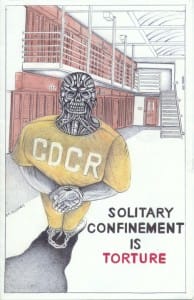
On the subject of SHU and Ad-Seg constituting torture, for those of us who may not be familiar with the specifics and in light of CDCr’s steady stream of propaganda – saying, “We don’t operate any solitary confinement units or cells in the California penal system, nor do we torture anyone” – here’s a summary of relevant facts supporting our position that these SHU and Ad-Seg units and the operations thereof are designed (modeled) after techniques designed to break political prisoners as a control mechanism. They are intended to break prisoners via coercive persuasion into becoming state informants.
I’ll begin by asking you a simple question?
Why is it that CDCr is able to get away with portraying PBSP SHU (Pelican Bay State Prison Security Housing Unit) prisoners as the “worst of the worst” sub-human monsters ever encountered in modern times as justification for their policies and practices of treating said prisoners as sub-human via decades of what is clearly a form of solitary confinement with sensory deprivation – and yet, as soon as these men agree to become state stooges via debriefing, they are no longer a threat and are released to the sensitive needs yard (protective custody) general population prison of their choice?
One of the main reasons they are able to continue to get away with their BS is the failure of the people to hold the lawmakers responsible.
I’ve been in the SHU for 28.4 years, to date, 24.7 years of which has been here in PBSP-SHU. [Editor’s note: This was written Dec. 30, 2014.] I’ve been challenging prison conditions in the courts since 1988, which is viewed as challenging prisoncrats’ authority, and up until our 2011 hunger strike protest, I’d never been formally charged with a gang related rule violation. (During our hunger strike I was issued two rule violations classified as serious. They were for: a) having a photo of my longtime friend; and b) a letter that someone had sent me, a stranger who represented herself as a supporter of our cause and wanted to be a pen pal. Staff gave me the letter, and then came around later and confiscated it and wrote me up.)
The above is intended to put the following into some perspective: Based on my personal experience in PBSP SHU during the past 24.7 years, I’ve experienced many techniques designed to break me. One is isolation from my social group. This is a tactic used here by prisoncrats to physically remove those prisoners deemed “problematic” to areas sufficiently isolated to effectively break or weaken close emotional ties, along with segregation of all natural leaders.
I’ve been challenging prison conditions in the courts since 1988, which is viewed as challenging prisoncrats’ authority, and up until our 2011 hunger strike protest, I’d never been formally charged with a gang related rule violation.
What prisoncrats like to do is claim that this place can’t be considered a solitary confinement unit because you have eight cells to each pod and thus the prisoners in each pod are able to talk to each other. But here is how it actually operates. If you are deemed a “problematic” prisoner by any of the staff – for example, if you are a prisoner who is constantly challenging the prisoncrats’ policies and practices – their way of subjecting you to an informal form of punishment or to try to break you is to put you in a pod where there are no other people of your social group.
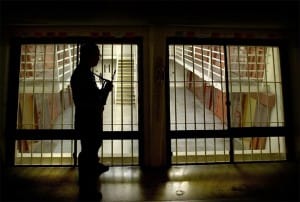
For example, if you’re an African, they’ll put you in a pod without any other Africans anywhere close to you so that you will not be able to speak to any other African prisoner for the duration of time you are on status with the staff. If you’re Southern Mexican (classified as Mexican Mafia), you’ll be put in a pod with no other Southerners – a pod composed of several Northerners, maybe a White and an African – the same if you’re a Northern Mexican or White.
Let me give you another example of this, so there is no misunderstanding: I received my CDCr number in December 1982, and in all my time in prison I’ve never had a problem with a cell-mate. In October 1990, I was set up and shot by a guard here in PBSP SHU. This is supported by a published 9th Circuit Court ruling, upholding the federal court jury verdict in 1995, finding the guard in question had subjected me to assault and battery. This injury caused permanent disability and, between 1990 to 2002, I had cellmates who would assist me with daily activities, such as washing the clothes we are not permitted to send to the laundry and with writing.
Between November 1995 and December 2002, the man I was celled with and I achieved three published rulings that were favorable for prisoners across the nation, in 2003. And in August 2002, the 9th Circuit Court overturned the District Court’s dismissal of one of our lawsuits regarding pepper spray decontamination policy issues, finding that it could proceed as a respondeat superior claim as well, a rarity in prisoner cases. And in September 2002, the District Court issued two permanent injunctions on our lawsuits re books and the ability to receive materials downloaded from the internet in our mail.
In response, the prisoncrats issued a memo in October 2002 in which they sought to further restrict prisoners’ incoming mail. We had an attorney contact the warden and the deputy attorney general representing CDCr in our lawsuits, demanding they cease their retaliatory acts in response to the injunctions we’d just obtained. And by November they rescinded the memo re mail restrictions.
Then on Dec. 3, 2002, they moved my cellmate and me to a lexan cell, a cell covered with lexan plastic which restricts air flow and the ability to communicate with other people in the pod even more, as well as being either too hot or too cold; and the following day they separated us. The pretext used to justify these retaliatory acts was an incident in another pod, wherein a White prisoner attempted to spear an officer. We weren’t in the same pod and had nothing to do with this incident and were never written up for being involved. We were both isolated from all other Whites and kept in the single cell lexan cells.
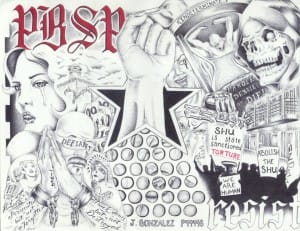
In July 2003, the associate warden granted my formal request to be able to double cell with a good friend, so that he could assist me with my daily activities, as per ADA (American Disabilities Act). He was then brought over to the lexan cell that I’d been in since Dec. 2, 2002.
We immediately began to challenge various conditions of confinement via the 602 inmate appeals process, and on May 19, 2004, we filed our lawsuit challenging our indefinite SHU confinement and related no-parole policies. This suit was a precursor to what is now our class-action lawsuit, and on June 8, 2004, we were single celled. I objected to this clearly retaliatory act, and they knew they had a problem because we’d been allowed to double cell in response to my formal ADA accommodation request in 2003, so they put us in cells side by side, so that my friend and cellmate could still provide assistance in the form of writing. We were still in the lexan cells.
In the interim, we’d been pursuing our civil suit, which had been dismissed a few times for technical reasons; and beginning in late 2009, we began to add peaceful activism activities to our challenges against illegal policies and practices regarding conditions of confinement, leading up to our hunger strike moves in 2011, which brought some international attention to CDCr’s torture policies and practices toward those of us who’ve been confined in the SHU for decades. And we were increasing the pressure via the prisoner class collective efforts we began in 2010, seeking to force the end to long term SHU, and we issued our historic Agreement to End Race-Based Hostilities in August 2012.
On Sept. 6, 2012, IGI (Institutional Gang Investigators) had me moved away from the collective as well as my assistant, into a cell covered in lexan, isolated from all other Whites. The IGI’s excuse or pretext for this clearly punitive move in response to my litigation and activism efforts – our attorneys had filed the paperwork seeking to amend our lawsuit as a first step towards seeking class-action status on behalf of all similarly situated PBSP SHU prisoners around May of 2012, and it was getting a lot of publicity in July-August 2012 – was that the move was done for my safety, which was 100 percent bullshit. But it’s another tactic used to try to break prisoners – reporting rumors with the intent of creating mistrust, convincing prisoners they can trust no one and are in danger and need the prisoncrats to protect them.
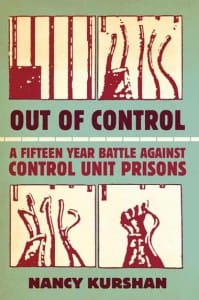
The above are all facts supported by solid evidence, and they constitute direct proof of CDCr’s policies and practices regarding decades of subjecting thousands to a form of torture for the purpose of coercion, as further demonstrated by the following excerpt from the 2013 book by Nancy Kurshan, “Out of Control: A 15 Year Battle Against Control Unit Prisons.”
On pages 12 and 13, she writes: “(R)esearch the prisoners had conducted … revealed a 1962 Bureau of Prisons (BOP) meeting in Washington, D.C., between prison officials and social scientists. Billed as a management development program for prison wardens, it coincidentally took place the same year the BOP opened Marion.
“Dr. Edgar Schein of MIT, a key player at that meeting, had written previously in a book entitled Coercive Persuasion about ‘brainwashing of Chinese Prisoners of War (POWs). …
“Schein put forward a set of ‘practical recommendations,’ throwing ethics and morals out the window.
“They included physical removal of prisoners to areas sufficiently isolated to effectively break or seriously weaken close emotional ties; segregation of all natural leaders; spying on prisoners, reporting back private material; exploitation of opportunists and informers; convincing prisoners they can trust no one; systematic withholding of mail; building a group conviction among prisoners that they have been abandoned by or are totally isolated from their social order; using techniques of character invalidation, i.e. humiliation, revilement and shouting to induce feelings of fear, guilt and suggestibility; coupled with sleeplessness, an exacting prison regimen and periodic interrogational interviews.”
These types of brainwashing strategies that involve physical as well as psychological abuse were being adopted from international arenas and applied inside U.S. prisons. Examples include the tactics used by the Brits to try and break the IRA prisoners and similar tactics refined by the West Germans to try and destroy the RAF (Red Army Faction), who were fighting the imperialism in their country, which is to a large extent due to the West German government policies per USA government dictates.
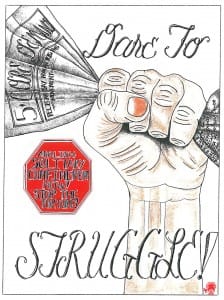
Now compare the above notes regarding the 1962 conference to Dr. Schein’s recommendations, with the examples of how they operate in the PBSP SHU, that I’ve also included above, and try to tell me such policies and practices aren’t intentionally imposed for the purpose of torturing prisoners into becoming state informants.
Remember, when the Legislature had hearings on said policies regarding long term SHU, they asked the CDCr prisoncrats for evidence to support their claims that said policies and practices were in fact making the prison system – and the public in general – safer and secure. And the prisoncrats couldn’t produce shit.
The bottom line is that CDCr’s long term SHU policies and practices are without any demonstrable positive purpose. They are intended to break prisoners down so they either go insane or agree to become informants for the state – period – which is 100 percent illegal.
Additional evidence that is as seriously harmful and painful is contained in the book by Matthew Lieberman, “Social: Why Our Brains Are Wired to Connect,” wherein Dr. Lieberman conducted studies using MRIs that demonstrated that people experience social and psychological pain in the same way they experience physical pain. It’s probably even more painful in the psychological context.
Here’s an example: Think about the worst painful experience you’ve ever had. Most people will think about the loss of a loved one or the breakup of a relationship, rather than a broken bone or other physical pain experience. It’s important to also remember that in addition to the circumstances and conditions prisoners are subjected to in the SHU or AdSeg environment is the fact that you are deprived of all semblance of normal human contact.
You are basically on sub-human, animal status for the duration of confinement in such units. You are always in a cage and/or in restraints, under escort by at least two guards, being observed by guards in the control booths who are armed with high power assault rifles.
The bottom line is that CDCr’s long term SHU policies and practices are without any demonstrable positive purpose. They are intended to break prisoners down so they either go insane or agree to become informants for the state – period – which is 100 percent illegal.
You are under constant surveillance via guards in the control booths and floor staff, who can and do listen to any and all conversations in the pods when men are talking over the tier and on the yards, via speakers on the yard walls. You have no physical contact with anyone other than while in restraints, via the guards escorting you with their hands on you, or at medical, where you are in restraints with guards hovering over you.
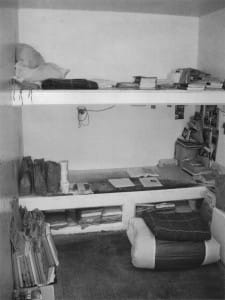
You have no physical contact with your loved ones. Those who are fortunate to get visits – a hardship for the majority of PBSP prisoners due to the remote location of the prison – visit behind glass, talking over a phone with a small video camera mounted on the wall. IGI staff are listening and observing you and your visitor the entire visit, and if either of you says or does anything the IGI observers don’t like, they can cancel your visit on the spot or, a few days or so later, they’ll issue you a write-up for alleged visiting violations and you end up on visit restriction for between 90 days to a year to permanently being banned from visiting with certain people.
Going back to Lieberman’s book, “Social,” it’s important to note that his studies included the subject of empathy, and he found that people really do “feel other people’s pain” when they observe people close to them being mistreated. The reason this is relevant is that not only are the prisoners being subjected to the above referenced coercive, torturous treatment FOR DECADES, but our loved ones and friends are subjected to the same psychological pain as we are. Supported by scientific studies conducted by Dr. Lieberman, and others, we find that the technique for conducting such studies has only become available over the past 10 years.
The point of the above summary is to educate the public and refute CDCr’s propagandistic claim, “We don’t operate solitary confinement units, nor do we torture any prisoners.” Facts prove otherwise.
What can people outside do about the above ongoing torture policies and practices by CDCr?
First, let me clarify a few things about where our cause presently stands from my perspective:
We successfully educated the public and exposed CDCr’s decades-old on-going subjection of thousands of prisoners to the torture of long term, indefinite SHU, via our peaceful activism efforts – the writing campaign (our formal complaint and other statements) and our three peaceful protest actions in the form of mass hunger strikes and work stoppages. By “we” I’m referring to those on the inside of these prison walls and our outside loved ones and supporters.
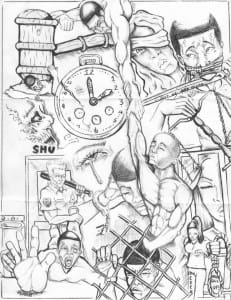
In my previous writings about our on-going struggle for real reform, the No. 1 priority being the end of long term solitary confinement, I’ve expressed the opinion that the prisoners remain responsible for leading this cause to victory via our actions inside these walls. And I’ve put myself out there with my peers pushing for additional peaceful actions on our part in here.
The response has been mixed, and it’s very difficult to get a collective consensus, as many of our outside people know. The administration has done all it can to prohibit us, the Short Corridor Collective, from being able to communicate. This began with IGI moving me from D1 block to D4 block on Sept. 6, 2012, and has continued with the recent move to D4-207, further isolating me from the prisoners who have influence in their respective groups, and the Step Down Program, with related transfers of many of the collective members to other prisons across the state.
Thus, I’ve had to reflect and re-evaluate our position. This is really not acceptable, and from my perspective is an excuse for non-action. Look, I’ve respectfully sent out several letters calling on the people to hold the lawmakers accountable.
It’s unbelievable to me to see the numbers of people out there who are aware of the continued torture we are subjected to, and yet they’ve failed to take any action to hold those responsible accountable.
The lawmakers must be held accountable
I’ve had to re-evaluate my prior perspective regarding prisoners continuing to lead this struggle in light of the above referenced factors. Subsequently, I snapped to the FACT that once we successfully exposed this torture program to the world, making the people aware, at least some of the responsibility shifts to the PEOPLE TO HOLD THE LAWMAKERS RESPONSIBLE.
And their failure to do so equates to THE PEOPLE enabling this to continue. The people have the power. The lawmakers hold their positions on behalf of their representative status – on behalf of the people.
It’s unbelievable to me to see the numbers of people out there who are aware of the continued torture we are subjected to, and yet they’ve failed to take any action to hold those responsible accountable.
With this in mind, here’s something people can do now towards holding the lawmakers responsible:
- Select a few of the lawmakers who we all know are in CDCr’s and CCPOA’s pockets for exposure as supporters and enablers of CDCr’s torture program, using social media to blast them worldwide. And you can also have people show up at their committee hearings to blast them as torture supporters. You’ll need to include references to public records supporting this position, such as the transcripts of the legislative hearings held regarding SHU, the September 2012 report by Amnesty International on PBSP SHU and the statements by Juan Mendez. The lawmakers you select for public exposure should be the five to 10 lawmakers who were the most vocal against Tom Ammiano’s bill
- Once these selected have come to be blasted in social media, you have a package together for presentation to the remaining lawmakers. The package needs to be a presentation supporting our position that this is a torture program, without cause or support for CDCr’s positions regarding making the system safer. Again, use the public records. And ask these lawmakers if they condone and support torture. Then, you present them with the things they can do to rein in CDCr’s abuse of power. This is a simple action. It’s something people can put in motion and have in motion while we plan our next moves.
Send our brother some love and light: Todd Ashker, C-58191, D4-207, P.O. Box 7500, Crescent City CA 95532.





